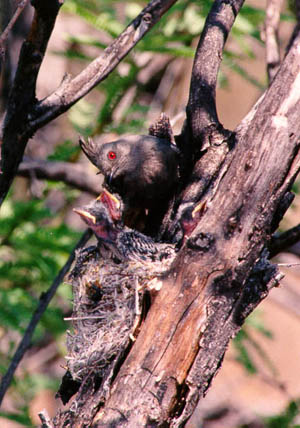Phainopepla Nest With Young Photograph and Sound Recording
Photo by Earle Robinson, April 1997, South Central Arizona
 Although Phainopepla are abundant in many parts of Arizona, they remain one of the most difficult birds to predict where they can be found in large numbers. An early nester, one can find the birds by the hundreds in some areas of southern Arizona building nests in early March (as observed in 1997). Then come succeeding years, 1998 and 1999, the birds are virtually gone from the same areas during the same time period. Somewhat dependent on mistletoe. (A parasite plant that is commonly found in the canopy of mesquite bosque forests in Arizona, and many other places as well.) One would think that a dry year and poor mistletoe production would force the birds elsewhere and a good year would draw them back. 1997 was a dry year but phainopepla nested early in the desert. 1998 was a very wet year, but the phainopepla were also gone from the same areas at approximately the same time. Could there have been a lot of casualties from the dry year and thus fewer birds to return in 1998? The Christmas bird count near Fountain Hills in 1998 had about as many phainopepla as other years, so this doesn't appear to be the cause. In 1999 the phainopepla were also gone, however, on the way to an atlas block on the verde river we passed through Cave Creek. North of Cave Creek, in the juniper forest, the phainopepla appeared to be numerous. 1999 was an extremely dry year in the winter and spring. Perhaps the birds were driven out of the desert into the juniper. Making the situation even more complicated, phainopepla are believed to have two broods, an early one in the desert and another much farther north at a higher elevation. Perhaps the birds just skipped the early nest and concentrated on the nest sites at higher elevations where the food supply was more plentiful in 1999.
Although Phainopepla are abundant in many parts of Arizona, they remain one of the most difficult birds to predict where they can be found in large numbers. An early nester, one can find the birds by the hundreds in some areas of southern Arizona building nests in early March (as observed in 1997). Then come succeeding years, 1998 and 1999, the birds are virtually gone from the same areas during the same time period. Somewhat dependent on mistletoe. (A parasite plant that is commonly found in the canopy of mesquite bosque forests in Arizona, and many other places as well.) One would think that a dry year and poor mistletoe production would force the birds elsewhere and a good year would draw them back. 1997 was a dry year but phainopepla nested early in the desert. 1998 was a very wet year, but the phainopepla were also gone from the same areas at approximately the same time. Could there have been a lot of casualties from the dry year and thus fewer birds to return in 1998? The Christmas bird count near Fountain Hills in 1998 had about as many phainopepla as other years, so this doesn't appear to be the cause. In 1999 the phainopepla were also gone, however, on the way to an atlas block on the verde river we passed through Cave Creek. North of Cave Creek, in the juniper forest, the phainopepla appeared to be numerous. 1999 was an extremely dry year in the winter and spring. Perhaps the birds were driven out of the desert into the juniper. Making the situation even more complicated, phainopepla are believed to have two broods, an early one in the desert and another much farther north at a higher elevation. Perhaps the birds just skipped the early nest and concentrated on the nest sites at higher elevations where the food supply was more plentiful in 1999.
Phainopepla (and other birds such as House Finch, Hooded Oriole, and Scott's Oriole) will build a nest in mistletoe balls, but are just as likely to use a tree branch as the photo above shows. If the mistletoe ball is very dense it becomes very difficult to identify which species built the nest.
The female and male are different colors. the male is very dark black and the female is a light grey. Both the female and the male will call year-round, a questioning "quoit?". The male can exhibit a repertoire of songs and call types, the most common being the "pretty boy" call.
The original Phainopepla sound recording was produced using a Sennheiser MKH70 shotgun microphone and the audio was stored on a 48 ksps DAT using a Tascam DA-P1 digital audio recorder. The recording was down-sampled to 44.1 ksps and converted to MPEG3 to reduce the file size.
download mpeg3 recording (phain.mp3)
Copyright Greg Clark, 1999
update 8/2012